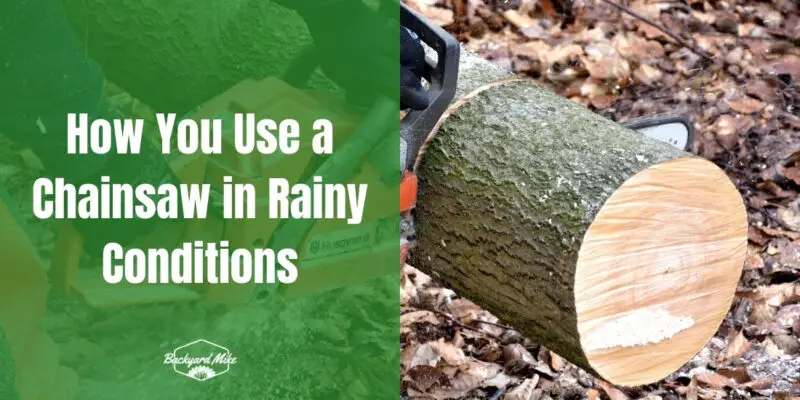Using a chainsaw in rainy conditions requires extra precautions for safety. Wear protective gear, including a helmet, eye and ear protection, non-slip gloves, and waterproof boots, to guarantee stability. Choose a gas or rain-suitable battery chainsaw, avoiding corded models due to shock risk. Address reduced traction and denser wood with caution, guaranteeing a clear workspace. Post-use, dry and maintain the chainsaw to prevent rust. Following these guidelines guarantees safe operation, and there's more to discover.
Key Takeaways
- Use a gas chainsaw for better waterproofing and durability in rainy conditions.
- Wear complete protective gear, including non-slip gloves and waterproof boots, for safety.
- Ensure the workspace is clear of obstacles to improve visibility and reduce hazards.
- Opt for chainsaws with anti-kickback chains to enhance safety during use.
- Dry and maintain the chainsaw post-use to prevent rust and ensure longevity.
Essential Safety Precautions
When handling a chainsaw, following essential safety precautions is critical, especially in rainy conditions. First, guarantee chainsaw safety by firmly holding the tool with both hands. Wet surfaces reduce friction, increasing slip risk, so wear complete protective gear, including helmets, eye protection, and ear protection. Non-slip gloves and waterproof boots with good traction are significant in rainy conditions. Stand on stable ground to prevent slipping. To avoid kickback accidents, use a chainsaw with a functional chain brake. Before you begin, inform others about your work area, particularly if you're working alone. Identify and manage hazards by examining the area for unstable branches or power lines and plan your escape routes. Avoid standing water to prevent electrical hazards, and keep clear visibility to assess potential dangers. Chainsaw chaps are essential for protecting legs and ensuring safety, especially when conditions are wet and unpredictable.
Choosing the Right Chainsaw for Rainy Weather
Choosing the right chainsaw for rainy weather is a key step in ensuring safe and effective operation.
Selecting the appropriate chainsaw for wet conditions ensures both safety and operational efficiency.
You'll want to focus on certain chainsaw features that offer weather resistance. Here are some tips:
- Gas Chainsaws: They're robust and generally have better waterproof features, making them ideal for wet conditions. Additionally, gas chainsaws like the Husqvarna 455 Rancher offer advanced air filtration for prolonged engine life, which can be especially beneficial in moist environments.
- Battery-Powered Chainsaws: These can be used if the manufacturer specifies they're suitable for rain, providing a cordless, safer alternative.
- Avoid Corded Electric Models: They pose a risk of electrical shock, making them unsuitable for rainy conditions.
- Check Durability and Build: Opt for chainsaws designed to withstand moisture, ensuring they meet safety standards and protect electrical components. Additionally, ensure that the chainsaw chain tension and condition are checked before use to prevent any operational issues during wet weather.
Challenges and Solutions for Cutting in the Rain
Operating a chainsaw in the rain presents several challenges, but with the right approach, you can manage these effectively.
Reduced traction and slippery grips are common issues, so wearing non-slip gloves and waterproof boots with good grip are essential. Visibility issues can be addressed by clearing your workspace of obstacles and using protective eyewear. It's important to remember that wet wood can be denser and harder to cut effectively, so extra caution is needed. Investing in chainsaws with safety features, such as anti-kickback chains and anti-vibration systems, can further enhance safety during operation.
For cutting techniques, slow and controlled cuts reduce accidents and improve safety. Avoid using electric chainsaws during rain due to electrocution risks. Instead, use a gas-powered model if possible.
Fatigue and reduced concentration can be mitigated by taking frequent breaks. Verify your chainsaw is well-maintained, with proper chain tensioning and extra bar oil for smooth operation.
Adhering to these solutions fosters a safer, more efficient cutting experience.
Post-Use Maintenance and Care
After handling the challenges of cutting in the rain, it's important to focus on post-use maintenance and care to keep your chainsaw in top condition.
Focus on post-use maintenance to ensure your chainsaw remains in top condition after rainy tasks.
Start by drying the chainsaw immediately to prevent rust. Here's a simple guide:
- Immediate Drying: Use a clean rag to thoroughly dry the chainsaw, focusing on the engine and electrical parts. This step is vital for rust prevention.
- Chain Cleaning: Remove debris and moisture from the chain and guide bar using a brush or cloth. This guarantees smooth operation. Wet conditions can lead to slippery surfaces, so ensure all parts are completely dry to prevent accidents during future use.
- Lubrication Techniques: Apply fresh chain oil to all moving parts. This prevents rust and guarantees your chainsaw runs smoothly next time.
- Proper Storage: Store your chainsaw in a dry, well-ventilated area to avoid moisture buildup.
Handling Emergency Situations Safely
Handling emergency situations safely while using a chainsaw in rainy conditions requires careful evaluation and planning.
Begin with emergency preparedness by evaluating weather conditions and ensuring your chainsaw is suitable for rain. Always wear essential safety gear, including helmets and non-slip gloves, to protect yourself. Clear your work area of obstacles, and maintain communication with others about your location and status.
In case of injury, have a well-stocked first-aid kit ready. Regularly inspect your equipment to prevent failures that could lead to emergencies. Ensure that proper chain tension and lubrication are maintained for effective cutting. Monitor weather changes closely, and be prepared to stop work if conditions worsen.
Follow established safety protocols and keep a stable position to avoid accidents. By staying alert and prepared, you can safely handle unexpected situations.
Frequently Asked Questions
Can I Use a Chainsaw in Light Rain Without Protective Gear?
You shouldn't use a chainsaw in light rain without protective gear. Chainsaw safety's essential. Prioritize rain precautions to guarantee control and prevent accidents. Wear helmets and gloves to belong to the safe and responsible chainsaw community.
What Type of Chainsaw Lubrication Is Best for Rainy Conditions?
Did you know 70% of chainsaw failures happen due to poor lubrication? Opt for high-viscosity oil in rainy conditions. Consider alternatives like biodegradable oils, fostering both performance and community responsibility. You're ensuring everyone's safety and efficiency.
How Do I Waterproof a Battery-Powered Chainsaw?
To waterproof your battery-powered chainsaw, embrace its water-resistant features. Focus on battery care by inspecting seals and electronic coatings. Regularly check for damage and follow the manufacturer's guidelines to guarantee you're part of the safe operating community.
Do Rainy Conditions Affect Chainsaw Warranty or Maintenance Contracts?
When it rains, it pours; this can impact chainsaw warranties. Always follow maintenance tips to guarantee warranty claims are valid. Consistent care shows you belong among knowledgeable users, safeguarding your investment despite unpredictable weather.
Are There Specific Chainsaw Brands Recommended for Wet Environments?
When considering chainsaw features for wet environments, look at brand comparisons. Husqvarna and Milwaukee offer models with water-resistant designs, providing reliability in rain. With these brands, you'll feel confident and connected to a community that values safety.
Conclusion
So, you've braved the rain with your trusty chainsaw. Remember, safety first: double-check your gear and be sure-footed. Your chainsaw should be right for wet conditions, otherwise, it's just a fancy paperweight. After working, clean and dry your tool, because rust is not your friend. If things go south, keep calm and prioritize safety. Chainsawing in the rain isn't for everyone, but with these tips, you'll be ready for the challenge.


